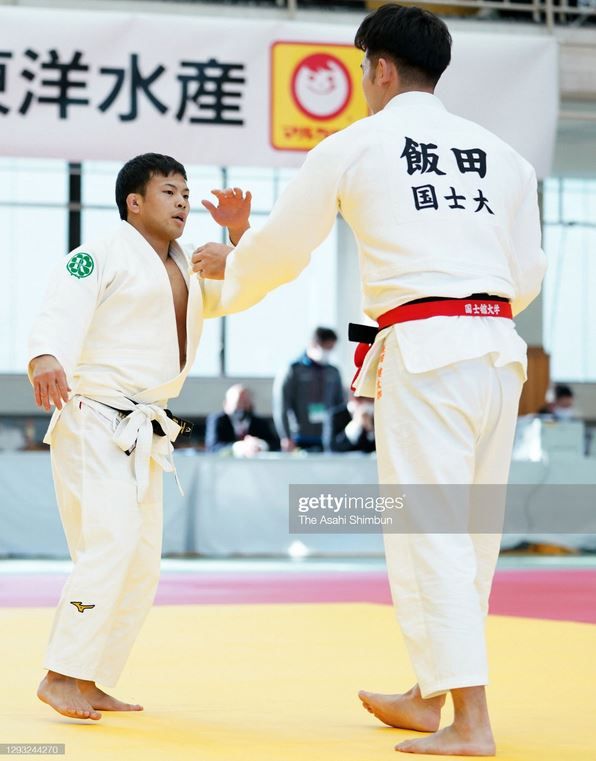
Occasionally, you have to fight bigger players. Usually this is not the case in shiai because there are weight classes. But in randori, sometimes there are not enough partners around and you have no choice but to fight much bigger players.
There are several things you need to be cognizant of:
Safety is a priority. Your number one concern is making sure you don't get hurt during the randori. It doesn't matter if you get thrown by your opponent. As long as you don't get injured, it's a win for you to have actually survived the exchange. Live to fight another day, so to speak.
Yes, it would be nice to throw a much-bigger opponent but leave your ego at the door. Your job is not to throw your huge opponent. Your job is to have a good randori and to learn from your randori experience. To achieve that, you must not get injured. You have to stay safe. So focus on the safety aspect above all else.
Just remind yourself at the start of the randori: "My job is to stay safe. I cannot afford to get injured here."
If you keep that in mind, you will be safe.
Fight differently. You cannot fight your much-larger opponent the same way you fight someone your own size. You would think this is a fairly obvious thing yet it is a remarkably common mistake beginners make.
Let's say a 60kg player is able to do a standing ippon-seoi-nage against someone who is also 60kg. It would be a big mistake to think he can do the same technique on a 120kg player. At best, that technique will be quashed. At worst, the 60kg player will get injured.
I repeat: Do not fight your much bigger and heavier opponent the same way you fight a lighter player.
Fight in defensive mode. When a player is much bigger, heavier and stronger than you (for example, 40 to 50kg heavier than you), you really must adopt a mindset of defensive playing.
Although as a rule of thumb it's always good to be on the offence, special circumstances call for a breaking of these rules. When fighting a bigger player, be a bit more defensive than usual.
Realize that bigger players generally do not do non-stop attacks like smaller players do. They are not as fast nor as nimble. In fact, they tend to be quite static. So, you can afford to slow down a bit and not be attacking all the time.
Understand that each time you attack, you are opening yourself up to being countered. This is manageable if you're dealing with an uke who is roughly your size. You might even be able to counter uke's counter because the strength and weight levels are roughly the same. This is not the case with a much-bigger opponent, who might not only counter you but might inadvertently injured you as well. So, attack but don't attack so much. Be a bit more defensive. You can afford to be so when fighting heavyweights.
Grip-fight ferociously. You have to out-grip a much-heavier player or else they will end up pulling your head down and dominating you. Then, it's just a matter of time before they smash you into the mat. At its most fundamental level, you have to prevent uke power hand from securing a grip on you. Never let him have a usable grip.
Look for counter opportunities. As a defensive player, you should be looking out for chances to counter uke but focus on the safe stuff. It isn't prudent to try to do ura-nage or tani-otoshi on a much bigger opponent. It does make sense to try to do ashiwaza counters against a bigger player.
As for offensive attacks, focus also on ashiwaza. If it fails, it fails. At least you won't get crushed by your opponent. You can safely get out of the way if your ashiwaza doesn't work. That is not true of all throws. Some throws will get you all tangled up. Kouchi-makikomi and ouchi-gari come to mind as examples of techniques where you can get entangled and injured if uke comes crashing down on you. But ashiwaza like de-ashi-barai, kosoto-gari, kouchi-gari, sasae-tsurikomi-ashi can be done safely.
Do some drop attacks. Standing attacks will be hard to do against someone bigger, stronger and heavier . Well-timed drop techniques (seoi-nage, seoi-otoshi) could work though, precisely because they are based on timing and not strength or brute force.
Drop attacks are safe because the positioning of your body does not put you in a hazardous situation. Even if uke is able to kill the technique, your limbs will not be all tangled up with theirs.
Generally speaking, sutemi-waza isn't advisable to use against a bigger player (never try soto-makikmi, ura-nage, yoko-guruma or tani-otoshi against a bigger player). But tomoe-nage is timing-based, so it can be used quite effectively against big opponents.
Remember, you cannot match your much-bigger opponent in terms of brute force, so don't even try doing techniques that require a lot of strength. Instead focus on techniques that are more timing based.
Be aggressive in newaza. If there's a chance to do newaza, especially if uke is in a turtle position, keep them on the ground (don't let them stand up) and attack them relentlessly.
In general, heavyweights don't like to do a lot of newaza. So, it is to your advantage to keep the fight on the ground for as long as possible. Just be careful not to get entangled during the newaza exchange or uke will roll you over and pin you. So, attack them with chokes and armlocks, but not osaekomi turnovers (too risky against a bigger player).
In a nutshell: Focus on safety. do not use the same techniques as you would against a smaller player, fight more defensively, attack with timing-based techniques and be aggressive in newaza.
